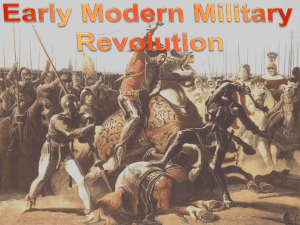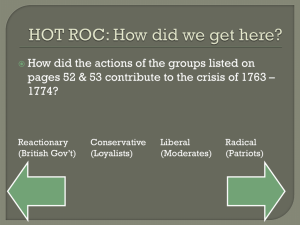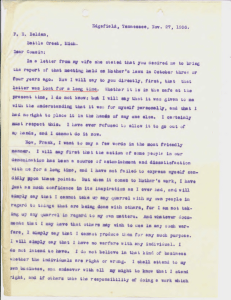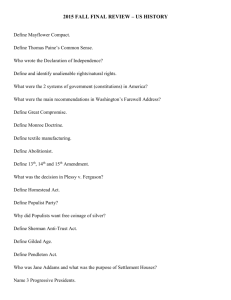Slide Presentation for 5 Bde Seminar
advertisement
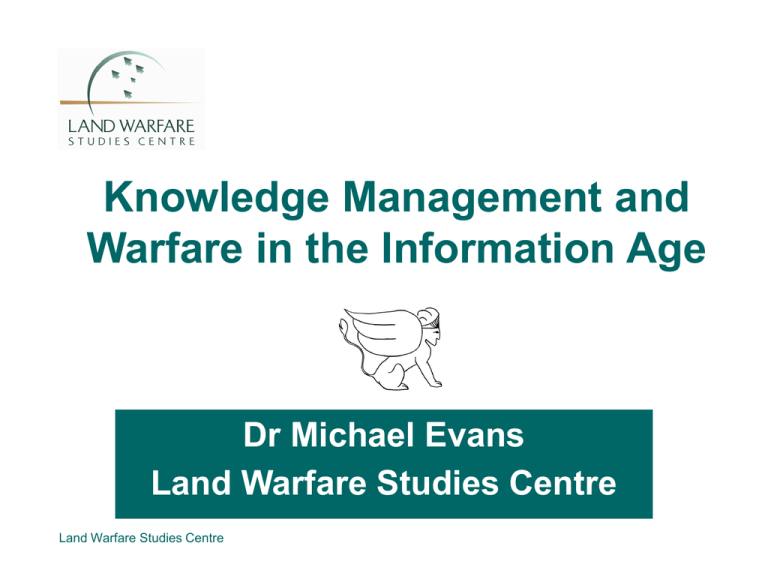
Click to edit Master text styles Knowledge Management and Knowledge and Warfare: The Revolution in Military Affairs Warfare in the Information Age Dr Michael Evans Land Warfare Studies Centre Land Warfare Studies Centre Click to edit Master text The Meaning of a Revolution styles in Military Affairs (RMA) The contemporary RMA refers to the transformation of war by informationage technologies such as computers, microelectronics and precision weapons Land Warfare Studies Centre Click to edit Master text The RMA and Information styles Superiority The cornerstone of the RMA is information superiority, the capability to collect, process and disseminate an uninterrupted flow of information while exploiting or denying an adversary’s ability to do the same Land Warfare Studies Centre Click to edit Master textof The US Philosophy styles Information Superiority ‘To find, fix, track and target - in near real time anything that moves or is located on the face of the Earth’. General Ronald R. Fogelman, Chief of Staff, US Air Force, February 1997 ‘Information superiority [is] at the core of military innovation’. General Henry Shelton, Chairman, US Joint Chiefs of Staff, March 1999 Land Warfare Studies Centre Click to edit Master text Three Themes of the styles Presentation Overview the American RMA and the role of knowledge in war Outline US Pentagon response to information-age warfare Assess Australia’s Knowledge Edge philosophy and its implications Land Warfare Studies Centre Click to edit Master text styles An Overview of the American Revolution in Military Affairs Land Warfare Studies Centre Click to edit Master text Key Technologies of the styles RMA C4ISR (command, control, communications, computers, intelligence, surveillance and reconnaissance) PGMs (long range precision strike) Stealth (low-observable platforms) Land Warfare Studies Centre Click to edit Master text Four Characteristics of styles the RMA Debate RMA is at once a process, a hypothesis and a debate RMA closely linked to globalisation and information revolution RMA largely an American phenomenon Notion of an RMA is attractive to Western theorists for cultural reasons Land Warfare Studies Centre Click to edit Master text styles American RMA Schools System of systems Dominant battlespace knowledge Global reach, global power school Economic determinists Contingent innovators Vulnerability school Essential continuity school Land Warfare Studies Centre Click to edit Master text System of Systems styles RMA School Promotes information superiority via situational awareness Believes information grid connecting ‘sensors to shooters’ will emerge Future of war lies in network-centric warfare (exploiting OODA Loop) Land Warfare Studies Centre Click to edit Master text Dominant Battlespace styles Knowledge RMA School Believes new technology will create DBK and transparent non-linear battlespace Believes that unity of C4ISR, PGMs and Stealth technology will make military operations full-dimensional Linear mass in war will give way to nonlinear ‘effects-based operations’ Land Warfare Studies Centre ClickDr toLibicki edit Master andtext The styles Terminator Vision Future warfare will be a conflict between machines (MEMS, robotics, nanotechnology battlefield meshes) The ‘small and the many’ will triumph over the ‘large, the complex and the few’ ‘To see is to know; to know is to be able to strike; to strike is to be able to win’ Land Warfare Studies Centre Click to edit MasterGlobal text Global Reach, styles Power RMA School Associated mainly with USAF and based on Rapid Decisive Operations (RDO) Promotes deep strike air power (B-2 bombers, cruise missiles, JDAMs) Sees evolution of USAF into an aerospace force based on UAVs/UCAVs and lasers Land Warfare Studies Centre Click to edit Master text Economic Determinist or styles Third Wave RMA School RMA shaped by civilian IT/knowledge economy Third Wave war: ‘the way we make war reflects the way we make wealth’ Third Wave militaries will be small, specialised and knowledge-based Land Warfare Studies Centre Click to edit Master text Contingent Innovation styles RMA School Looks to lessons of military history for guidance (e.g. 16th century gunpowder revolution and 20th century blitzkrieg doctrine) Argues that military revolution springs from technology added to knowledge (doctrine and concepts) Land Warfare Studies Centre Click to edit Master text Technology, Knowledge styles and Military Revolution [A military revolution] occurs when the application of new technologies into a significant number of military systems combines with innovative operational concepts and organisational adaptation in a way that fundamentally alters the character and conduct of conflict Andrew Krepinevich, ‘From Cavalry to Computer: Patterns of Military Revolution’ (1994) Land Warfare Studies Centre Click to edit Master text The Vulnerability RMA styles School Fears rapid weapons proliferation, WMD threat and asymmetric challenges ‘Future may not be “Son of Desert Storm” but “Stepchild of Somalia and Chechnya”’ - General Charles C. Krulak, USMC (1996) Fears of this school realised on September 11 with al-Qaeda attacks on US homeland Land Warfare Studies Centre Click to edit Master text Essential Continuity RMA styles School Sees no revolutionary paradigm shift in warfare Believes in military transformation rather than military revolution Warns that many RMA models ( e. g. blitzkrieg) were based on evolution not revolution Land Warfare Studies Centre Click to editofMaster text The Heart the American styles RMA Debate At the heart of the RMA debate lies the impact of electronics, computers and precision munitions on warfare and the notion of a transition towards ‘information-age knowledge based warfare’ although there are differences over pace and direction Land Warfare Studies Centre Click to edit Master text styles Towards Knowledge Warfare: The Pentagon and the RMA Land Warfare Studies Centre Click to edit Master text Main Features of styles Joint Vision 2020 Seeks information superiority by: dominant manoeuvre (using IO) precision engagement (missile power) full-dimensional protection (battlespace control) focused logistics (force sustainment) Land Warfare Studies Centre Click to edit Master textover US Military Caution styles Transformation Lack of RMA consensus provides limited options for rapid force transformation Uneven technology means much experimentation and field trials RMA developments in computers, electronics, munitions not matched by revolution in sensors or platforms Land Warfare Studies Centre Click to editSystems Master text Legacy and styles Information Superiority US still requires ‘legacy’ systems (artillery, manned aircraft, helicopters) Legacy systems accompanied by revolutionary weapons systems (JDAMs, UAVs, UCAVs) Complete information superiority still an aspiration rather than a reality Land Warfare Studies Centre Click to edit Master text styles The Experience of Kosovo NATO had information superiority but: Did not achieve full battlespace awareness or perfect precision Aircraft struck wrong targets and could not stop ethnic cleansing by Serbs Sensor technology was inadequate Campaign showed dangers of ‘information saturation’ Land Warfare Studies Centre The of Click to Experience edit Master text styles Afghanistan USAF pulversised Taliban/al-Qaeda but: Unlike Kosovo key role played by Special Forces and Afghan proxies Overreliance on PGMs led to possible escape of Osama bin Laden Air power like teenage sex offers instant gratification not lasting commitment Land Warfare Studies Centre The Precision Revolution Click to edit Master text and Knowledge-Based styles Warfare Parts of RMA greater than whole From information superiority to DBK still more theory than reality Precision revolution coexists with legacy systems Land Warfare Studies Centre Click to edit Master text styles Australia and the Knowledge Edge Land Warfare Studies Centre Click to edit Master text Defining the Knowledge styles Edge Outlined in 1997: as ADF’s highest capability priority and defined as ‘the effective exploitation of information technologies to allow us to use our relatively small force to maximum effectiveness’ Land Warfare Studies Centre Click to edit Master text The RMA’s Potential for styles Australia [The RMA will introduce] a fundamentally different style of warfare . . . where distance offers no protection; where if a target can be found it can be destroyed; where the most precious commodity will be information and the most deadly military weapon will be speed’ Ian McLachlan, Minister for Defence, June 1996 Land Warfare Studies Centre Click to edit Master text and Information Warfare styles the ADF Knowledge Edge ‘Information warfare. . . The ‘Revolution in Military Affairs’ . . . Is where our comparative advantage over potential adversaries is likely to last longest. In coming years, it will be harder for Australia to match regional numbers of platforms such as ships and aircraft’. Defence Review 2000: Our Future Defence Force, June 2000 Land Warfare Studies Centre Click to edit Master text Developing the Knowledge styles Edge in the 21st Century A Knowledge Edge exists when, as a result of leveraging and exploiting information, communications and other technologies, and by the application of human cognition, reasoning and innovation, there is a comparative advantage in those factors that influence decision making and its effective execution ADF Brief on the Knowledge Edge, June 2000 Land Warfare Studies Centre Click to edit Master text Defence 2000 and the styles Knowledge Edge 2000-12 A $2.5b to be spent on ADF Information Capabilities Will include JSF, stealth, ARHs, UAVs and UCAVs ‘Knowledge Edge will be the foundation of our military capability’ Land Warfare Studies Centre Click to edit Master text Knowledge Management styles and the Knowledge Staff ADF Knowledge Staff created in mid-2001 Focuses on Network-Enabled Warfare (NEW) and creating a surveillance system NEW described as ‘warfare deriving power from robust, rapid networking of well-informed, rapidly deployable forces and/or effects’ (July 2002) Land Warfare Studies Centre Click toCharacter edit Masteroftext The the styles Australian Knowledge Edge Viewed in terms of American RMA schools: Is a blend of system of system and contingent innovation schools Growing recognition of asymmetric challenge may mean closer affinity with vulnerability school Land Warfare Studies Centre Click to edit Master text styles Conclusion Land Warfare Studies Centre Click to edit Master text styles Future Scenarios to 2025 Likely: system of systems or variant of DBK will emerge making the battlespace much more transparent Unlikely: a Terminator-style battlefield mesh based MEMS, robotics and biotechnology. These trends are in their infancy operationally Land Warfare Studies Centre Click to edit Knowledge Master text and Information, styles Wisdom What shapes the conduct of international relations and therefore the course of history is not only the number of people with access to information; it is more importantly how they analyse it. Since the mass of information tends to exceed the capacity to evaluate it, a gap has opened up between information and knowledge, and even beyond that, between knowledge and wisdom Henry Kissinger, Does America Need a Foreign Policy? (2001) Land Warfare Studies Centre Click to edit Master text 21st Century Modes of styles Conflict Pre-modern conflict (religious terrorists, low-tech ethnic militia) Modern conflict (conventional wars a la Gulf or Korea) Post-modern conflict (combinations of high-tech warfare and casualty limitation) Land Warfare Studies Centre Click to edit Master text Why a Knowledge Edge is styles Important in War War is a matter of vital importance to the State; the province of life or death; the road to survival or ruin. It is mandatory that it be thoroughly studied Sun Zi, The Art of War Land Warfare Studies Centre Click to edit Master text styles Questions? Land Warfare Studies Centre

